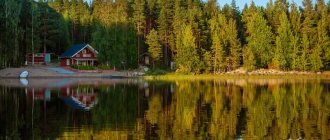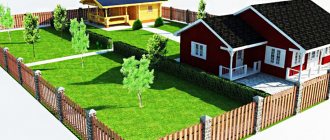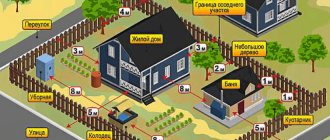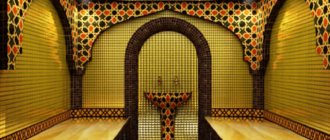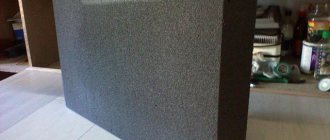It’s hard to believe, but many still don’t know what the main difference between a sauna and a traditional bath is. Let's conduct a small educational program: the sauna is a dry-air procedure, and the temperature in the steam room is approximately 2 times higher than in a Russian bath. From here we draw a completely reasonable conclusion, which will be especially relevant for those who want to build a sauna: in order for everything to work out, you should carefully think through all the nuances and abandon improvisations. Your ingenuity should give way to cold calculation, based on strict adherence to the prescribed standards for sauna design. What are these norms? Is it possible to build a wonderful sauna without damaging any of them? All this will be discussed in as much detail as possible in today’s material.
Where to begin
So, at first, a timid thought about construction finally took shape into a completely mature and serious intention. Well, it’s time to get down to the most important thing - and this is not purchasing the necessary material, no, no. First you need to draw up a thoughtful project plan for the future sauna. And so that it turns out to be more than just your stupid fantasies, take into account the basic design standards when developing it. All of them are spelled out in a set of regulations of a technical, economic and legal nature - in fact, they are what are taken into account during any construction on the territory of our country. Briefly, this code is called SNiP, and it is this that we will take today as the starting point for the construction of a sauna.
Regulations
There are quite a lot of regulations regulating the activities of bath and sauna organizations.
The main ones are:
- ZPPP No. 2300-1.
- SanPiN 1.2. 3150-13 (a document regulating both the design and operation of saunas).
- SNiP 31-05-2003 (rules for the construction of housing and communal services).
- SP 118.13330.2012/SNiP 31-06-2009 (requirements for public buildings).
- Federal Law No. 123, pay attention to table 11. This law is a technical regulation of fire safety (fire safety).
- NPB 110-03 (list defining the types of knowledge to be protected by automatic fire extinguishing systems and automatic fire extinguishing systems).
Before starting work, make sure that local authorities have not provided you with a SNiP specially developed for the city or region.
Private or public?
Surely, the difference between a private and public sauna is easily understood by you even at the semantic level.
Public saunas are those that are created by individual entrepreneurs or commercial organizations to attract customers and subsequently make money. They can be either built into a large building or made in the form of separate buildings.
Private saunas, as a rule, are built as an extension to the house. Or in the form of separate buildings. They are used by a limited number of people and cannot be a means of making money.
SNiP provides different standards for the design of private and public saunas, and if you want to carry out the construction correctly, it will not be superfluous to familiarize yourself with their key provisions.
Fire distances
Compliance with the prescribed standards during construction helps prevent the movement of fire from one building to another. For example, if you have set up a sauna in a separate building, and next to it there is a country house or a country cottage.
The distance to the fence, as well as to the neighbor’s bathhouse or sauna is also taken into account. The final norm depends on the type of materials used to decorate the walls of the sauna.
- to the fence of the neighboring plot - at least 3 meters;
- when finishing with brick or concrete blocks, the distance to the neighbor’s sauna is at least 6 meters;
- when finishing with any other materials - at least 8 meters.
How much money do you need to start a business? How much does a sauna cost?
The key question when opening a new business is how much a sauna costs, how much money is needed to equip and repair a sauna, how much money you need to have to promote and promote sauna services.
The initial investment in opening a sauna depends on the region, but on average is:
- Major repairs and decoration of the premises - 600,000 rubles;
- Purchase of necessary equipment and furniture – 300,000 rubles;
- Purchase of all necessary accessories for the sauna – 30,000 rubles;
- Website creation and advertising campaign – 80,000 rubles.
Total: 1,000,010 rubles.
In addition to the initial investment, you will need monthly expenses for:
- Salary for sauna employees – 90,000 rubles;
- Utility payments and rent of premises - 70,00 rubles;
- Advertising and promotion – 20,000 rubles;
- Replenishment of sauna accessories – RUB 10,000;
- Unforeseen expenses and expenses in the event of force majeure circumstances – RUB 20,000.
Total: 210,000 rub.
If the sauna is located in a residential building
Very often, a sauna is integrated into a residential building. Therefore, when designing, you cannot do without SNiP standards. And they are clear:
- the sauna is isolated from other rooms of the house by partitions made of safe, non-combustible materials;
- It is ideal to use concrete or brick as such materials, and it is convenient to make reinforced concrete floors
Some people make their own sauna on their balcony. Before deciding on such an initiative, you should carefully weigh the pros and cons, and also make inquiries with the housing authorities.
Important points of interior layout
Often craftsmen try to make a stove themselves, trying to save on construction costs. However, the design standards for bath rooms (as well as sauna rooms) are very strict in this regard. The oven must have:
- factory production;
- automatic protection;
- turn off every eight hours until completely cooled down;
- switch off at a critical temperature of more than 110 degrees Celsius.
At the same time, for finishing a steam room in a sauna, it is recommended to use those wood species that do not emit any flammable resins at all. For example, hardwoods are great.
Among other recommendations, which in some cases can be successfully perceived as safety standards, we can note the installation of a metal pipe around the perimeter of the ceiling, which is connected to the water supply of a residential building. In the event of a fire, all you need to do is turn on the water and the fire will be eliminated very quickly.
A separate issue is the placement of the sauna in the basement. Safety standards imply this option only if there is direct access to the street from the basement. Moreover, the exit should be both directly from the steam room, evacuation type, and from the equipped locker room. Otherwise, not a single fire inspectorate will sign such a project plan for you.
Attention should also be paid to the fact that the cables must be thermally insulated and designed to operate at a threshold temperature. If you use a heater, be sure to build a heat-insulating shield over it - use reliable fire-resistant material for manufacturing.
Requirements for ensuring epidemic well-being
These requirements imply:
- monthly activities to exterminate rodents and parasites;
- ongoing elimination of defects in floors and walls (as cracks form);
- weekly general cleaning;
- routine cleaning during the working day;
- the final “promenade” of the cleaning employee at the end of the working day, the last cleaning is done with the mandatory use of disinfectants.
The SES will definitely check the disinfection log and the consumer’s corner in the sauna.
Some important SNiP standards
6.18 A dry heat bath (sauna) consists of: a dry heat chamber, the area of which is determined at the rate of 2 m2 per place, but not less than 10 m2 (not counting the airlock at the entrance to the chamber), the height of the chamber is 2.2-2.3 m , capacity should not exceed 10 people; dressing rooms at the rate of 1.5 m2 per place in the cell, but not less than 12 m2 and a toilet with it for 1 toilet; shower with one net for every 2 places; rest rooms at the rate of 2 m2 per place in the cell, but not less than 12 m2; a contrasting bath with a water surface 2x2 m and a depth of 1.2 m, usually located in the same room as the shower room.
3.7. When designing, it is recommended to install the heater directly on a concrete floor with a thickness of 100 mm or more. Before installing the heater, it is necessary to carry out thermal insulation using brickwork with a thickness of at least 12 cm (other similar heat-resistant materials can be used). The distance from the heater to the protective material must be 150 mm according to the standards, and the distance from the combustible lining of the steam room to the heater must be no less than 70 cm vertically and 50 cm horizontally.
3.8. a complex sauna must be provided with a separate evacuation exit to the outside;
Fire extinguishers for baths
Carbon dioxide and freon fire extinguishers are rarely used - CO₂, that is, carbon dioxide is poisonous. Foam and water products are effective, but run out quickly.
The standard for saunas is powder fire extinguishers (OP), air-emulsion fire extinguishers are also effective, but they are prohibitively expensive. These devices are the most universal, for several fire classes and for electrical installations. A 2 - 4 liter cylinder is not enough, it takes a few seconds of release, it is better to choose a 6 - 8 liter container, quantity - from 2 pcs.
What can cause a fire?
Even the most competent sauna layout cannot guarantee the occurrence of an emergency. Especially if the sauna was commissioned many years ago and is regularly used for its intended purpose. Over time, the wood used for wall decoration loses moisture, which dramatically increases the likelihood of fire even at relatively low temperatures.
An unfortunate combination of factors (the stove did not turn off in time, overheating of the air in the steam room) can lead to a critical fire hazard. Therefore, there is a very specific recommendation - to completely change the lining inside the steam room every 6 years. And even though visually it remains just as fresh and reliable: you will never see the deformation of its structure with the naked eye.
What else should you pay attention to in order to prevent a fire hazard?
- gross errors in the installation of furnace equipment;
- no cuts or concessions when integrating the stove into the steam room space;
- improper operation of the chimney;
- malfunction of the electrical equipment used;
- incorrect connection of the irrigation system to the general water supply channel, etc.
A selection of ready-made sauna plans for use
Of course, the proposed options are not a panacea, and they must be agreed upon with regulatory authorities. In addition, most of them require correction when transferred to your site. Take seriously the minimum distance of the sauna or bathhouse to the fence or to another structure in the neighboring area. However, this is not a problem if you know the theoretical part and are well acquainted with the standards for integrating a sauna into any living space.
Sauna as a business: analysis of the market and competitors
If we consider a sauna as a business, first of all you need to find out how in demand this service is in your city and conduct a competitor analysis. The main consumers of services in this niche are men and women aged 20 to 45 years. Finnish saunas, rather than Russian baths, are more popular among this group of clients.
Please note that competition in this market is very high. A significant part of the market (about 80%) in Russia is occupied by medium and large organizations; small businesses own only 12% of baths and saunas in the country. The category of medium and large enterprises includes baths and saunas owned by municipalities (with the form of ownership - municipal unitary enterprises) and having the status of public baths.
A significant part of large and medium-sized saunas are located in fitness centers, spa centers, and swimming pools. They offer their clients a high level of service and a large selection of related services with multiple visits throughout the month or year. The cost of visiting these establishments is usually significantly higher than a sauna with a standard set of services, if this visit is paid separately. But often for clients of these establishments, visiting the sauna is free, since it is included in the general package of services.


